VC Solar App - Configuration
The VC Solar App is configured in this section. In the finished app, the VC Solar App can be accessed via the
solar icon in the toolbox.
Clicking on opens configuration window, which shows the available
configuration options.
The configuration is divided into 10 sections:
Static Parameter
In the Static Parameter section, all default values are configured which cannot be adjusted by the user in the app and are required for the calculation of profitability.
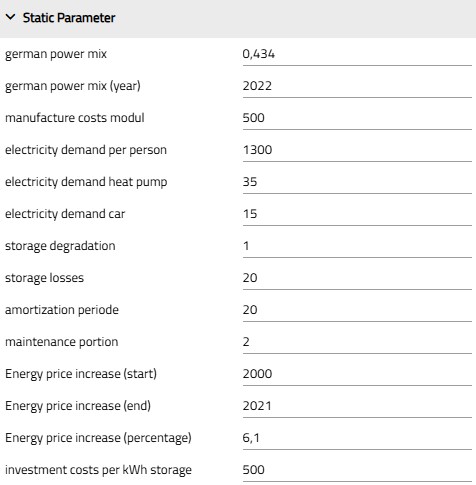
The following settings are available in the Static Parameter section:
| Option | Unit | Description |
|---|---|---|
german power mix |
kg/kWh |
A solar panel does not emit any CO₂ when generating electricity. CO₂ is only emitted during the production of solar modules due to the manufacturing energy required. To calculate the CO₂ savings, the amount of energy generated by the PV system is compared with the CO₂ equivalent of the German power mix. |
german power mix (year) |
year (a) |
The value for the CO₂ equivalent of the German power mix is updated annually. State the year for which the "German power mix" value was specified here. |
manufacture costs modul |
kg/kWp |
The CO₂ emissions of a PV module are often expressed in kg CO₂ per installed kilowatt peak (kg CO₂/kWp) to quantify the environmental impact of manufacturing and installation. The life cycle analysis of a PV module shows that the CO₂ emissions for the production, transportation, installation and disposal of a module can range from around 500 to 1,500 kg CO₂ per kilowatt peak (kg CO₂/kWp). This value varies depending on factors such as: - Manufacturing technology and location: Production processes and energy sources in the country of manufacture influence emissions. - Transport routes: Long transport routes can worsen the CO₂ balance. - Module materials: Different materials and their fabrication can lead to different emission values. |
electricity demand per person |
kWh/Person/a |
Electricity consumption per person varies greatly depending on the region, lifestyle and technological equipment. In Germany, the average annual electricity consumption per person is around 1,300 to 2,000 kilowatt-hours (kWh). However, this amount can vary depending on the household and individual habits. In the finished app, the electricity demand can be calculated automatically based on the size of the household. |
electricity demand heat pump |
kWh/m²/a |
To calculate a simplified estimate of the electricity demand of a heat pump per square meter, average values for the efficiency of the heat pump are used. - A well-insulated building has an annual electricity demand of 18 kWh/m² - An averagely insulated building has an annual electricity demand of 25 kWh/m² - A poorly insulated building has an annual electricity demand of 38 kWh/m² |
electricity demand car |
kWh/100km |
The amount of electricity an electric car consumes per 100 kilometers depends on several factors, including the type of vehicle, driving style, road conditions and the use of air conditioning or heating. In general, the energy consumption of electric cars is around 15 to 20 kilowatt hours (kWh) per 100 kilometers. |
storage degradation |
%/a |
Storage degradation refers to the process of gradual reduction in the performance of an energy storage system over time and use. This degradation can be seen in reduced capacity, reduced charging and discharging efficiency and a shorter service life of the storage system. The storage degradation indicates the annual percentage of capacity losses of the storage system compared to the previous year. |
storage losses |
%/a |
When using a PV storage system, various losses affect the overall efficiency. These losses mainly originate in the following areas: - Conversion losses (DC/AC and AC/DC) - Storage losses - Self-discharge of the battery - Losses due to the battery management system - Circuit losses This means that around 20% of the PV energy generated is lost. The actual losses can vary depending on the specific system and operating conditions. |
amortization periode |
years (a) |
An amortization period is assumed for the calculation of profitability. This is 20 years on average and can be adjusted here if necessary. |
maintenance portion |
% |
The operating costs of a PV system include various aspects that are incurred regularly or over the lifetime of the system. For PV systems, the operating cost ratio is usually between 1% and 5% of the investment costs per year. This rate can vary depending on the size of the system, location, quality of components and specific maintenance requirements. Smaller systems tend to have higher operating cost ratios, while larger systems benefit from effects of scale and have lower ratios. |
Energy price increase (start) |
Year (a) |
In the Customize Consumption Data section of the app, the help text for energy costs allows you to specify the average electricity price increase over a certain period. This parameter indicates the start year of the period. |
Energy price increase (end) |
Year (a) |
In the Customize Consumption Data section of the app, the help text for energy costs allows you to specify the average electricity price increase over a certain period. This parameter indicates the end year of the period. |
Energy price increase (percentage) |
% |
In the Customize Consumption Data of the app, the help text for energy costs allows you to specify the average electricity price increase over a certain period. This parameter indicates the percentage (%) increase in electricity price. |
investment costs per kWh storage |
€ |
To calculate the investment costs for a planned energy storage system, the associated costs must be taken into account. A defined cost factor per kWh of storage capacity is applied for this. |
| Apply applies the changes made to the displayed app. See also Editing and Saving |
Default Values
All default values are configured in the Default Values section, which are suggested to the user in the app, but can be personalized by the user.
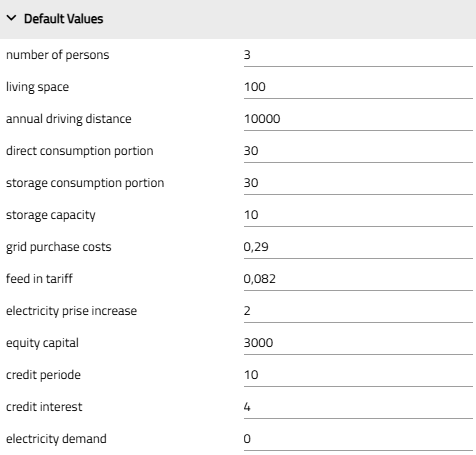
| Option | Unit | Description |
|---|---|---|
number of persons |
Number |
Pre-set number of people belonging to the household. |
living space |
m² |
The size of the living space is required to calculate the individual amount of electricity required by the heat pump each year. |
annual driving distance |
km |
The driving distance is required to calculate the individual share of the e-car in the annual electricity demand. |
direct consumption portion |
%/a |
The direct consumption share of a PV system refers to the proportion of self-generated solar power that is consumed directly in the household instead of being fed into the public grid. A high proportion of direct consumption can increase the profitability of the PV system, as the self-consumed electricity reduces the cost of purchased grid electricity. By increasing the proportion of direct consumption, savings on electricity costs can be maximized and the payback period of the PV system can be shortened. |
storage consumption portion |
%/a |
The storage consumption share of a PV system describes the proportion of self-generated solar power that is initially stored in a battery storage system and later consumed in the household. A high proportion of storage consumption can increase the autonomy of a household, as more of the solar power generated can be used even when the PV system is producing little or no energy (e.g. at night or in bad weather). |
storage capacity |
kWh |
To calculate the investment costs for a planned energy storage system, the associated costs must be taken into account. A defined cost factor per kWh of storage capacity is applied. |
grid purchase costs |
€/kWh |
Grid purchase costs for a PV system refer to the costs for the electricity that a household or company must purchase from the public grid if the self-generated solar power is not sufficient to cover the current demand. These costs can be reduced through various measures. |
feed in tariff |
€/kWh |
The feed-in tariff for PV systems is the price that operators of a PV system receive for the solar power fed into the public grid. This tariff is often determined by statutory regulations and subsidy programs and can vary depending on the country and when the system is installed. |
electricity prise increase |
%/a |
The rise in electricity prices is an important factor that owners of PV systems should take into account. Rising electricity prices make self-generated solar power increasingly valuable compared to grid electricity and improve the profitability of the PV system. |
equity capital |
€ |
The equity capital associated with PV systems refers to the financial assets or resources that an owner or investor provides to buy, install and operate the system. It plays an essential role in the financing and profitability of the PV system. |
credit periode |
a |
The credit period for a PV system refers to the period over which a credit to finance the system is repaid. The duration depends on various factors and can vary depending on the individual situation. |
credit interest |
% |
The credit interest rate for a PV system refers to the interest rate at which the borrowed capital is provided for the construction or financing of the system. This interest rate is a crucial factor in the total cost of financing and directly influences the profitability of the investment. |
electricity demand |
kWh/a |
The electricity demand of a PV system refers to the electrical energy demand that the PV system is to generate to cover self-consumption or to feed into the public grid. The demand can vary depending on the specific requirements and needs of the system owner. In addition to the option of automatically calculating the electricity demand based on the parameters for household size, storage consumption and any existing electric car, an already known electricity demand can be specified directly, e.g. from the previous year’s consumption. |
| Apply applies the changes made to the displayed app. See also Editing and Saving |
Consumption Profiles
In the Consumption Profiles section, the shares of direct consumption and storage consumption are defined for five different profiles.
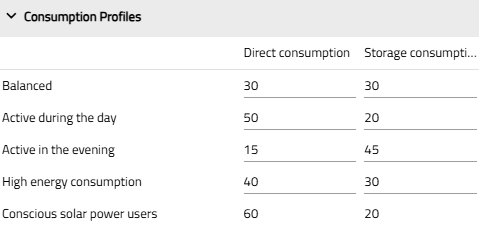
| Option | Unit | Description |
|---|---|---|
Balanced |
% |
Percentage of direct consumption and storage consumption for an electricity demand that is evenly distributed throughout the day and night. |
Active during the day |
% |
Percentage of direct consumption and storage consumption for an electricity demand that is increased during the day. |
Active in the evening |
% |
Percentage of direct consumption and storage consumption for an electricity demand that is increased in the evening. |
High energy consumption |
% |
Percentage of direct consumption and storage consumption for an above-average electricity demand. |
Conscious solar power users |
% |
Percentage of direct consumption and storage consumption for users who consciously optimize their solar power usage. |
| Apply applies the changes made to the displayed app. See also Editing and Saving |
Global Settings
Settings for the general configuration of the app are defined in the Global Settings section.

Option |
Unit |
Description |
VC Solar Layer available |
boolean |
See "Solar Layer Name". In addition to the solar layer name, it must be specified that a solar layer is available in order to activate the corresponding functions. |
solar layer name |
Layer name |
VC Solar consists of two components, which are also offered as a VC Solar Bundle. One is the VC Solar Backend for area-wide 3D solar potential analyses and the other is the VC Solar App for interactive solar potential analyses directly in the VC Map. VC Solar Backend enables the precise determination of monthly direct, diffuse and global solar radiation on all roof and wall surfaces of your building stock. The software takes into account the shading caused by vegetation and city model objects. With a simple click on the respective surfaces, the solar radiation data is displayed and analyzed in intuitive diagrams. The software also allows the area-wide solar cadastre to be updated independently as required. To integrate a pre-calculated solar layer from VC Solar Backend and make it available as an input layer for the profitability calculation, the layer name must be specified. |
Create debug features |
boolean |
In the event of a bug, feature and console outputs can be generated to simplify troubleshooting. |
Split tables into pages |
boolean |
Tables can be displayed either paginated or continuously. |
Number of rows per table |
Number of Entries |
When tables are paginated, the default number of rows per page can be defined. |
i18n String for info page |
i18n string |
To provide a customized application description and include additional information, an information window can be opened via the info button in the app’s main view. The content of this page is written in Markdown and created as an i18n string in the Internationalization section. |
start info page at start |
boolean |
The information page can be set to open automatically when the app starts. |
| Apply applies the changes made to the displayed app. See also Editing and Saving |
VC Solar Backend Settings
In the VC Solar Backend Settings, all default values are configured which are required for the calculation of the solar energy production.
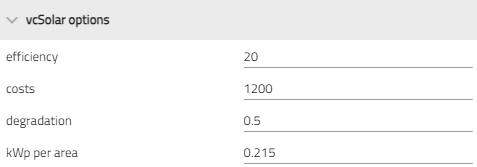
| Option | Unit | Description |
|---|---|---|
efficiency |
% |
The efficiency of a PV system refers to the ratio between the electrical energy generated by the system and the irradiated solar energy. This efficiency is influenced by various factors and is decisive for the performance and profitability of the system. |
costs |
€/kWp |
The cost per kWp (kilowatt peak) for PV systems varies significantly and depends on several factors, including the type of modules, installation costs, the size of the system and regional differences. |
degradation |
% |
Degradation in PV systems describes the gradual loss of performance of the solar modules over time. This process is normal and is influenced by several factors. In general, the degradation of PV modules is collected and analyzed through extensive testing and long-term data to enable accurate predictions of future performance. |
kWp per area |
kwp/m² |
The installed output of a PV system (kWp per m²) varies depending on the type of solar modules, their efficiency and the respective installation method. |
| Apply applies the changes made to the displayed app. See also Editing and Saving |
Global Diagram Colors
In the Global Diagram Colors section, the global diagram colors for the light and dark color themes are defined.

| Option | Unit | Description |
|---|---|---|
Outline color |
HEX Color Code |
Color for the outline in bar charts. |
| Apply applies the changes made to the displayed app. See also Editing and Saving |
Diagram Colors – Revenue/Expense Plan
In the Diagram Colors – Revenue/Expense Plan section, the diagram colors for individual values within the light and dark color schemes are defined.
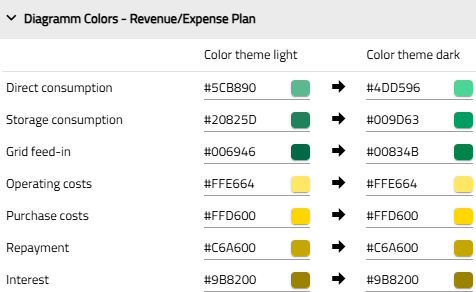
| Option | Unit | Description |
|---|---|---|
Direct consumption |
HEX Color Code |
Color for the direct consumption share. |
Storage consumption |
HEX Color Code |
Color for the storage consumption share. |
Grid feed-in |
HEX Color Code |
Color for grid feed-in. |
Operating costs |
HEX Color Code |
Color for operating costs. |
Purchase costs |
HEX Color Code |
Color for purchase costs. |
Repayment |
HEX Color Code |
Color for repayment rate. |
Interest |
HEX Color Code |
Color for interest rate. |
| Apply applies the changes made to the displayed app. See also Editing and Saving |
Diagram Colors – Liquidity Trend
In the Diagram Colors – Liquidity Trend section, the diagram colors for individual values within the light and dark color schemes are defined.

| Option | Unit | Description |
|---|---|---|
Positive liquidity |
HEX Color Code |
Color for positive liquidity. |
Negative liquidity |
HEX Color Code |
Color for negative liquidity. |
| Apply applies the changes made to the displayed app. See also Editing and Saving |
Diagram Colors – CO2 Savings
In the Diagram Colors – CO2 Savings section, the diagram colors for individual values within the light and dark color schemes are defined.

| Option | Unit | Description |
|---|---|---|
Savings |
HEX Color Code |
Color for positive CO₂ savings. |
Manufacturing emissions |
HEX Color Code |
Color for emissions from production. |
| Apply applies the changes made to the displayed app. See also Editing and Saving |
PDF Export
In the PDF Export section, customization options for PDF export are defined.
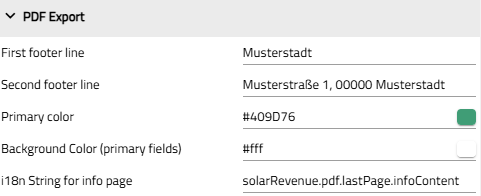
| Option | Unit | Description |
|---|---|---|
First footer line |
Text |
The footer of the PDF contains contact information in two customizable lines. |
Second footer line |
Text |
The footer of the PDF contains contact information in two customizable lines. |
Primary color |
HEX Color Code |
The design of the PDF report is defined by a primary color. This corresponds to the primary color used for the VC Map and can be customized if needed. |
Background Color (primary fields) |
HEX Color Code |
For all elements placed on primary-colored elements, the color can be adjusted here. |
i18n String for info page |
i18n String |
For customizing the application description and adding further information, the PDF export includes a final information page, which can be created as an i18n string in Internationalization. However, this section does not support text formatting such as bold, italic, etc. and logos cannot be included either. Paragraph breaks are achieved using \n. |
| Apply applies the changes made to the displayed app. See also Editing and Saving |